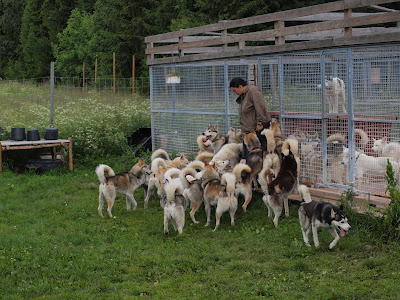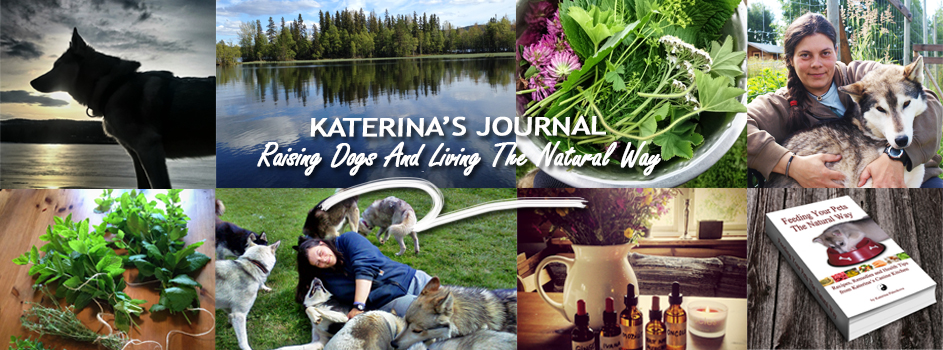Have you ever wondered what do dogs or other animals think?
Since I was little, I always had this strong feeling of empathy, especially for animals. As I was growing up, I was amazed at their communication and realized more and more that most of it the language of the body, rather than sounds or „words“.
I was always taught to believe dogs have different barks instead of words, for different things, which is of course true, but these „expressions“ are just a small part of their full, rich language.
Some people believe that animals, if they could, would talk back to them in human language, or even more specifically, in their particular language. So a dog with a Portugese owner would talk to them in Portugese. Hmm, and if that owner had a spouse who was from Canada, would the dog switch to English? Automatically a billingual dog!
I owe my understanding of the dog language to sharing my life with a large pack of siberian huskies, one of the most natural breeds that exist. I am grateful to them for teaching me their language, their words and expressions and mainly for opening my eyes and heart to communicating with animals.
But dog language is not the only thing I want to write about today.
What I would like to share here are my thoughts on the mutual communication between humans and their animals, on finding that common language that we all would easily understand. Idealistic and utopic you think? It´s been proven already to work out great, a long time ago.
It is no secret that we humans want to dominate everything on this planet. That we want and force all the other species and everyone else, hence, some of us have even tried to force other nations, to speak our language and to submit to our rules.
So we tell our animals what to do our way and automatically expect them to understand it and submit to it. If they don´t, we punish them.
Imagine how you would feel if the entire life you only knew English and someone came and told you in Chinese that you should do this and this. And you would not understand. And instead of finding a mutual communication tool, some kind of bridge, your counterpart would punish you because you did not understand them, and thus did not do what they wanted you to do. Surreal? Unfair? Drastic? Isn´t it?! And yet, that is exactly what we do to our animals. To the ones so many of us love and addore.
When I first got hold of books written by ethologists (animal behaviorists), telling fascinating storries of how they watched different animals interact and communicate with each other, and then learned and applied their language to be able to interefere, and what amazing results they were getting, I felt this was exactly the right way. But I realized and understood that not everyone has the possibility or deisre to speak only Dog. After all, we are humans, they are animals and most of us will not make that step to actually chose to speak their animal´s language entirely. Don´t worry, I am the same way. Although I have learnt and adapted a number of words and phrases from my dogs that I use in my daily communiation with them.
But all that realization led me to something I thought was great. As a matter of fact, I still think it´s great and I highly recommend it to everyone.
I actually urge you, if you love and respect animals, to try it out.
What if we were to create a bridge, or a whole new language, not human, not animal, but something in between, that we and our dog, or cat, or horse, or bird, would both understand.
In search for that, still at a very young age, I realized that one such tool is the use of body language. I mean, just think about it. When you watch dogs playing, or a herd of horses interfering, or a group of dolphins, or fleet of geese, they do not communicate only verbally. They still do use all their honking, and barking, roaring, whining, howling, but the major part of their communication is nonverbal. It is the talk of the body that does most of the conversation.
 |
| Communicating and working with a large pack is about mutual understanding, respect and love |
When I read this information, it really struck me. I immediately remembered my first English lessons, that were incredibly effective. I was ten and few times a week after school, my dad would drop me off for a private lesson. My teacher was Canadian and she taught English in international school. I knew only a few words I learned out of natural couriostiy for the English language, and it was not enough to start any kind of c
onversation. Yet, my progress and learning curve were fascinatingly high. My teacher showed me every word she taught me, or explained it in sort of a pantomima. It was not only entertaining and fun to learn, but so quick to understand. My brain took those new words and information in like a mushroom would soak in water. No need to remember and list in dictionaries in search for translations of words. Besides, she did not speak a word Czech. I learned 90 percent through body language.
And so do our animals. They do not actually know what it means to „hop on the sofa“ or „come here“, but because we would graphically show them by clapping our hand on top of the sofa, or making a move with our body, showing towards us, they get the cue and do what we ask them to.
Many of us don´t realize how much we actually tell our animals by our body moves, we do it subconsciously and they look for those cues, learn to interpret them and communicate with us. They are the true masters of reading our body (and mind). That makes me think of how intelligent they really are. They live often isolated from their kind, from their own race, in this human created world, with human rules and language, where majority is not interested in making compromises or to learn about the animals´ needs and the language they use to tell us what they want, like, don´t like, fear, desire, wish, what hurts them, what stresses them, how they feel, what they love, what they prefer, whom they want to play with, whom they don´t trust, and so on.
Imagine it would be you living in that kind of world in their position. Wouldn´t it be nice to consider our animals´ natural behavior and language and come at least half way and say: „I will listen to you, buddy, and what you have to say. And I will do my best to make it easier for you to communicate with me“.
 |
| Young and old, high ranked and the absolute omegas of the pack, they all join in for a fun exercise and treats from their human, in harmony. |
And it is definitely doable. Actually, it is really easy.
Just watch your animals as they play and observe how they behave when they are trying to tell you something. Sooner than you think, you´ll learn to read their body language and understand what they are trying to say to you.
Try to implement more body language while you communicate with them. Watch yourself what you automatically do when you say „come“ or „sit“. You will soon realize that you already, unknowingly make a certain move, even if it is a slight wave of a hand, or shake of your head, or leaning to a certain side. All this is your body language that your animal reads.
Learn to become aware of these communication tools and use them more consiously. You can even add new ones if you want. It´s all up to your fantasy. Do you want to teach your dog a new trick? Or do you want to create a „word“ that would mean something that you both would mutually understand, for example „now let´s play“? Just decide what unverbal cue (or move) you are going to use and use it every time you want to go play with your dog. He or she will understand it in no time.
Read articles and books. Education is good and today there are so many cool and awesome books covering the topic of communicating with animals. Books that are not only borring scientific encyklopedia, but fun, interesting stories to read and learn from.
I will gladly send you a list of recommended books on this topic, just let me know in a comment or drop me an email.
But one thing I haven´t mentioned yet. There is already an awesome communication bridge for humans and animals, out there. For quite a while. It´s been sientifically proven highly effective and functional and is used even with the wildest, untamed animals. The method of clicker training.
Many of you probably know clicker training as one of many training methods for dogs. Some of you most likely even think that is is used for training border collies and connected with obedience, dog dancing and agility. Don´t let these shortsighted assumptions limit your opitons of communicating with your animals. Clicker training has been found by a group of animal behaviosts and scientists mainly to communicate with dolphins, other sea and wild animals, with fish, porcupines, you name it. Today it is used for literally any kind of animal training of any kind of animal. I have seen clicker trained chickens, lamas, cats, goats, coalas, baby sloans (yes, I am not kidding!), bears, horses, parrots, mice, even a cocroach.
Clicker training is not just a training method, but rather a communication tool. And a philosophy. Philosophy of positive aproach to animals, to teaching without fear, to creating relationships full of understanding, love and respect for each other. Without fear. I like to think of it as that bridge where our animals and us can meet half way and say: „hey, I understand what you are telling me. I understand what you want. What you desire. Let´s have a chat. Let´s find a way that will be mutually acceptable. Let´s treat each other with respect“.
Remember, EVERYTHING IS POSSIBLE! All you need is WANT and DO and IT WILL HAPPEN :)




1 comment:
Hi!
i just found your Site and really like it!
I would be happy if you could point me in good directions concerning bodylanguage. Well the more indepth the better.
I just read the first book of Shaun Ellis and i'm totally crazy about it! I hope 'Wolf Talk' arrives soon.
I'm just preparing for my first dog - And I want a Husky because they are such friendly dogs and I want a dog that is able to keep up with us in our winter aktivities. Well taht is only the tipp of the Iceberg I fell in love with the breed.
Greetings from Germany
Ziska
Post a Comment